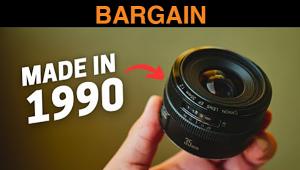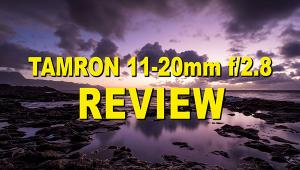Tamron 100-400mm f/4.5-6.3 Di VC USD Lens Review


While the main body of my work has been with lenses such as the 24mm fixed, wide angles, and mainly my trusty 16-35mm zoom, I have often found myself wanting a long zoom for the scenes that present themselves along the way. It’s not that I am unwilling or just plain lazy to get closer—a long zoom, like the recently released Tamron 100-400mm, simply changes the way I see and helps me explore other visual options.
Yes, a lens like the Tamron 100-400mm is implicitly bulkier, thus not something I’d choose for street photography, and requires a rethinking of the use of depth of field and slower shutter speeds, but the rewards of rewiring my brain to see through its “eye” are great, and fun to boot.
Specs
Formally, the new lens from Tamron is called the 100-400mm f/4.5-6.3 Di VC USD ($799). Translated, this means the lens offers a max aperture of f/4.5 at 100mm and f/6.3 at longer focal lengths; the “Di” means it’s designed for full-frame cameras; VC stands for its image stabilization features (up to 4 EV); and USD indicates it contains an Ultrasonic Silent Drive that offers fast and smooth AF operation. Available mounts are for Canon and Nikon DSLRs. More on those features and how they perform in the hands-on report that follows.
There are other acronyms that speak to the design and operation of the Tamron 100-400mm lens. It contains a high-speed Dual MPU (microprocessor) that does double duty for accurate AF as well as vibration compensation, an excellent compensation for this relatively slow lens when shooting in low light that helps keep ISO settings reasonable.
The Tamron 100-400mm lens features an eBAND (Extended Bandwidth & Angular Dependency) Coating—a multilayer coating technology that increases both light transmission and has excellent anti-reflection characteristics—and has a fluorine coating (for ease of cleanup and lens surface protection) and is moisture-resistant. Plus, it is compatible with the company’s TAP-in Console, for firmware updates with select cameras.
There’s one other feature of note for the Tamron 100-400mm, especially for nature and wildlife photographers: the lens is compatible with Tamron’s 1.4x and 2.0x teleconverters, albeit with a 1 EV light reduction for the 1.4x and 2 EV loss with the 2.0x. This loss has implications, however, as the effective light loss may hinder or eliminate the ability of a camera to autofocus at max apertures at and beyond f/8, due to the way the camera’s AF system is set up.




Some cameras may be fine with the converters, but some, particularly older models and those that have not been firmware upgraded, may not allow for AF, may limit AF areas to smaller focusing points within the frame, or, since the effective aperture of this lens narrows as you zoom out, cut out AF operability at longer focal length settings. For example, the widest aperture on the lens at 400mm is f/6.3. Factor in the 2x light loss and the lens is now above the f/8 threshold.
My best advice is to research which camera models allow for f/8 max aperture AF operation before investing in a teleconverter and factor in the light loss: one stop for the 1.4x and two stops for the 2.0x. You can find lists of cameras from Nikon and Canon that would be problematic on the Internet by searching “f/8 autofocus max aperture.” Of course, manual focus will work OK.
For those who want to take the Tamron 100-400mm lens on walkabouts and especially when packing a bag for travel, the lens weighs in at 39.3 ounces, about 2.5 pounds: add a good-sized DSLR and the optional Arca-Swiss tripod mount and the difference between this package and mounting a 24mm fixed prime is palpable. I should note that Tamron claims that this is the “lightest” weight lens available “in its class.”
As to packing and choice of bag, the Tamron 100-400mm measures 7.7 inches when unmounted at the 100mm position. In the field and when mounted, add in another 2.5 inches for your typical DSLR body, three inches for the lens hood (recommended in directional light conditions), and another four inches when zooming out at the 400mm setting, and this becomes one long item to have and hold. That’s where the VC range comes into play.

Hands-On
I tested the Tamron 100-400mm f/4.5-6.3 Di VC USD with a Canon full-frame DSLR and the mount was firm and tight, and I am assured well sealed. I was supplied with the optional Arca-Swiss tripod mount adapter ($129).
On the left-hand side of the Tamron 100-400mm’s lens barrel, there’s a two-stage vibration compensation switch (#1 for hand-held on a stable surface and #2 for panning, plus an Off position) and a focus choice and “limiter” switch. The switch helps speed AF and limits the “search,” from infinity to about 25 feet and from 25 feet to five feet, the closest focusing distance at any focal length. You can override AF with MF tweaks. On the right side, there’s a “lock” switch that keeps the lens from searching, invaluable when you are focusing on, say, birds among the branches that may snag focus as you recompose.

The Tamron 100-400mm lens is well marked as to focal length positions, and the knurled MF and zoom controls on the barrel are responsive and smooth to the touch. In addition, the Arca-Swiss adapter is easy to mount, and has white dots to assure correct angles when changing from vertical to horizontal compositions. Naturally, make sure you have followed instructions to ensure a tight fit. I mounted the setup on a Vanguard Alta Pro 2+ tripod with ball head and found the combo ideal: be sure to position the rig so the camera/lens sits between the legs for extra security.
In the Field
I tested the Tamron 100-400mm lens in and around the Connecticut shoreline with my Canon DSLR right after a good snow dump this winter. I made sure to test the Tamron 100-400mm lens at all focal lengths with and without VC.
As mentioned, my usual rig is a wide prime or short zoom, and of course the balance and weight difference was a change of pace. After adjusting my stances and handholding technique, and usually shooting with VC activated, the Tamron 100-400mm lens proved to be an exciting and high-quality tool. Focusing was smooth and fast, in both manual and AF realms. Working close was a new experience, as at five feet I could get right in there for intimate details using any focal length. At 400mm the lens retains sharp and crisp details (see the crop shot in illustrations).

I did not notice any vignetting at the edges even at fairly narrow apertures, speaking of which the aperture range on Tamron 100-400mm allows you to stop down to f/32 at 100mm, f/40 at 200mm, and f/45 at 400mm. As to the widest aperture capability, it’s f/4.5 at 100mm, f/5.6 at 200mm, and f/6.3 at 400mm. I worked with VC for all handheld shots: remember to turn off VC when the camera is tripod mounted.
For handheld shots with the Tamron 100-400mm I usually used shutter priority set at a minimum of 1/400 second, habit I suppose, but always had the option, and usually set VC as backup insurance. I rarely had to toss any shots due to shake, even though I expected more of the same. The VC is visually apparent, as the image seemed to “set” in the finder. All that meant my ISO rarely got above 400, well within the range (ISO 3200) of quality.
What struck me most was how the Tamron 100-400mm lens performed in contrasty winter light. Usually I have to compensate somewhat for deep shadow and bright highlight conditions, but the Tamron handled contrast in often startling fashion, and I was able to record the mood of the light without having to resort to pumping up the shadow areas and suppressing highlights when processing the Raw files.

Conclusion
Overall, the Tamron 100-400mm f/4.5-6.3 Di VC USD lens was a pleasure to use. I did need to adjust my shooting habits to handle this large optic, and my camera/lens/tripod adapter combo was not light of weight or short in size, but once I got past that I found that it lent itself to exploring new visual opportunities, which got me excited about working with a long-range tele zoom. At $799, it’s an affordable option that will pay you back with sharp, quality images. If you haven’t worked with a lens with this range and capabilities, it will offer you a new way to work in the field and will get you to “see telephoto” in short order.
- Log in or register to post comments

















































